

Conflict in Europe 1935-1945: Course of the European War Flashcards. World War II General Resources. WWII Web Sites Encyclopedia of the Second World War The Second World War is a Spartacus Educational website and enables one to research individual people and events of the war in detail.

The sources are “hypertexted” so that the visitor can research the newspaper, organization, etc., that produced the source. There are several subsections including those on: Background to the War; Nazi Germany, Chronology of the War, Political Leaders, European Diplomacy, Major Offensives, British Military Leaders, USA Military Leaders, German Military Leaders, Japanese Military Leaders, The Armed Forces, The Air War, The Resistance, Scientists & Inventors, War at Sea, Resistance in Nazi Germany, The Holocaust, War Artists, Weapons and New Technology. HyperWar: World War II Hyper War is a “hypertext” history of the second World War and features diplomatic and political documents.
World War II Sites This site serves as a gateway to World War II sites appropriate for students and teachers. U.S. Program. World War Two Timeline. Conflict in Europe 1935-1945. Colonial Fascism: Mussolini's invasion of Abyssinia. Hitler and Mussolini meet in Rome. Hitler, Stresemann and the Discontinuity of German Foreign Policy. Hitler, Stresemann and the Discontinuity of German Foreign Policy. Lebensraum Policy or Propaganda? Mussolini’s Fascism. Neville Chamberlain and Appeasement. World War Two. Lesson03.pdf. Berlin in July 1945 (HD 1080p color footage) World War II Documentary. The Rise and Fall of the Third Reich. Life in Hitler's Germany Part 2. Life in Hitler's Germany Part 1.
WWII The Complete History Part 13 of 13. WWII The Complete History Part 12 of 13. WWII The Complete History Part 11 of 13. WWII The Complete History Part 10 of 13. WWII The Complete History Part 9 of 13. WWII The Complete History Part 8 of 13. WWII The Complete History Part 7 of 13. WWII The Complete History Part 06 of 13. WWII The Complete History Part 05 of 13. WWII The Complete History Part 04 of 13. WWII The Complete History Part 03 of 13. WWII The Complete History Part 02 of 13. WWII The Complete History Part 1 0f 13. Apocalypse - The Second World War - Episode 6 - Inferno 1944 - 1945. Apocalypse The Second World War Ep 5 6 The Great Landings The Noose 1942 1943. Apocalypse The Second World War Ep 4 6 World Ablaze 1941 1942. Apocalypse The Second World War Ep 3 6 Shock 1940 1941. Apocalypse: The Second World War - 2/6 - Crushing Defeat (1939.
Apocalypse: The Second World War - 1/6 - Aggression (1933. Birth of the Blackshirts. Nazi Party v Weimar. Fascist v. Nazi. Nazi-Soviet Pact. Nazi-Soviet Pact. In the 1930s Joseph Stalin became increasingly concerned that the Soviet Union would be invaded by Nazi Germany.
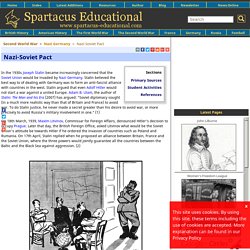
Stalin believed the best way to of dealing with Germany was to form an anti-fascist alliance with countries in the west. Stalin argued that even Adolf Hitler would not start a war against a united Europe. Adam B. Ulam, the author of Stalin: The Man and his Era (2007) has argued: "Soviet diplomacy sought (in a much more realistic way than that of Britain and France) to avoid war. To do Stalin justice, he never made a secret greater than his desire to avoid war, or more precisely to avoid Russia's military involvement in one.
" (1) On 18th March, 1939, Maxim Litvinov, Commissar for Foreign Affairs, denounced Hitler's decision to occupy Prague. Neville Chamberlain, the British prime minister, did not like the idea. A debate on the subject took place in the House of Commons on 19th May, 1939. Joseph Stalin realized that war with Germany was inevitable. The Foreign Policies of Hitler and Mussolini. Hitler's Foreign Policy. Mussolini's Foreign Policy. Foreign Policy. Nazi Foreign Policy. Fascist Foreign Policy. Fascist v. Nazi. League of Nations. During the First World War several world leaders such as Woodrow Wilson and Jan Smuts, began advocating the need for an international organization to preserve peace and settle disputes by arbitration.
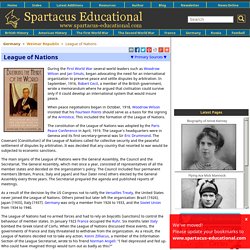
In September, 1916, Robert Cecil, a member of the British government, wrote a memorandum where he argued that civilisation could survive only if it could develop an international system that would insure peace. When peace negotiations began in October, 1918, Woodrow Wilson insisted that his Fourteen Points should serve as a basis for the signing of the Armistice. How the League Dealt with International Conflicts. Structure of the League. Failure of The League of Nations.
League of Nations. The League of Nations Basics. Weaknesses in the foundation and structure of the League of Nations. Abyssynia. The Abyssinian Crisis. The Abyssinian Crisis – The Awful Warning. Spanish Civil War - more detail. The Spanish Civil War. Guernica. 5.. Hitler and the Spanish Civil War. 4. Spanish Civil War - Worksheet. 3. Spanish Civil War Source Analysis.
2. The Spanish Civil War –The Basics. 1. Spanish Civil War. Spartacus - Appeasement. Neville Chamberlain became Prime Minister of Britain on 28th May, 1937.

Over the next two years Chamberlain's Conservative government became associated with the foreign policy that later became known as appeasement. Chamberlain believed that Germany had been badly treated by the Allies after it was defeated in the First World War. He therefore thought that the German government had genuine grievances and that these needed to be addressed. He also thought that by agreeing to some of the demands being made by Adolf Hitler of Germany and Benito Mussolini of Italy, he could avoid a European war. (1) Joachim von Ribbentrop was ambassador to London in August, 1936. According to Christopher Andrew, the author of Defence of the Realm: The Authorised History of MI5 (2010) MI5 were receiving information from a diplomat by the name of Wolfgang zu Putlitz, who was working in the German Embassy in London.
Before leaving for Germany, Nevile Henderson read a copy of Hitler's Mein Kampf. Appeasement and the Road to War. Organising Appeasement. Invasion of Poland. 1 Sep 1939 - 6 Oct 1939 Contributor: John Radzilowski Political Situation Poland had been reborn as an independent nation after World War I and the collapse of Austria-Hungary, Russia, and Germany.
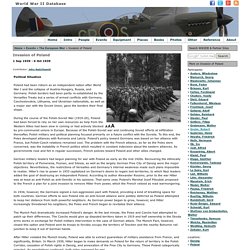
Polish borders had been partly re-established by the Versailles Treaty but a series of armed conflicts with Germany, Czechoslovakia, Lithuania, and Ukrainian nationalists, as well as a major war with the Soviet Union, gave the borders their final shape. During the course of the Polish-Soviet War (1919-20), Poland had been forced to rely on her own resources as help from the Western Allies had been slow in coming or had actively blocked by pro-communist unions in Europe. German military leaders had begun planning for war with Poland as early as the mid 1920s. In 1934, however, the Germans signed a non-aggression pact with Poland, providing a kind of breathing space for both countries. Invasion of France and the Low Countries. 10 May 1940 - 22 Jun 1940 Contributor: C.
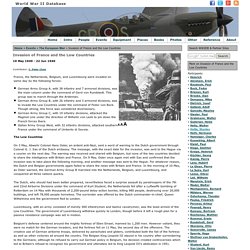
Peter Chen. 6. France Falls. 5. Germany Invades Poland. Hitler Invades France. Invasion of Holland. Invasion of Belgium. Invasion of Holland. 1940 British troops land in Norway. 1940 Denmark invaded. Poland 1939. WW2 - Invasion of Poland. Blitzkrieg: A Blueprint for Victory. Blitzkrieg Tactic. 3. YouTube Clips on the Fall of Poland. 3. German Advances Powerpoint. 2. German Advances - HSC Online. 1. German Advances. The War in the Air - Crossword. The Second World War - Extra Reading. 7.The Air War and its Effects. 6.. The air war and its effects - HSC Online. 5. The Bombing of Germany. 4. The Blitz. 3. Battle of Britain - World War II. On June 17, 1940, the defeated French signed an armistice and quit World War II.
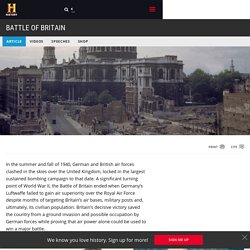
Britain now stood alone against the power of Germany’s military forces, which had conquered most of Western Europe in less than two months. But Prime Minister Winston Churchill rallied his stubborn people and outmaneuvered those politicians who wanted to negotiate with Adolf Hitler. But Britain’s success in continuing the war would very much depend on the RAF Fighter Command’s ability to thwart the Luftwaffe’s efforts to gain air superiority. This then would be the first all-air battle in history. In fact, Britain’s situation was more favorable than most of the world recognized at the time. Even more serious, the Germans had poor intelligence and little idea of British vulnerabilities. The Reader’s Companion to Military History.
3. Battle of Britain - World War II. 2. Battle of Britain - Worksheet. 1. The Battle of Britain - BBC History.